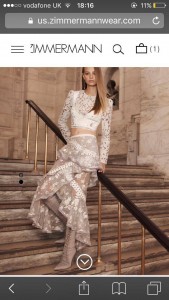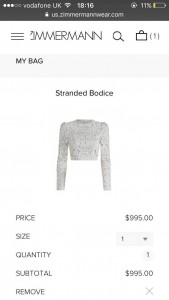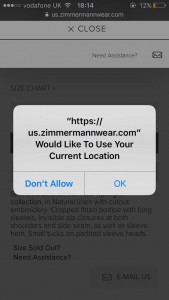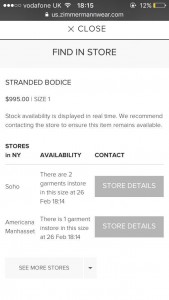Bespoke Experiences for Online Luxury Customers
As luxury retailers accept the inevitable and begin to invest in their e-Commerce offerings, a huge selling point for the more traditional brands is the potential to gather valuable information on their customers. With CRM pegged as a crucial 2017 investment for fashion retailers, the insight available through analytics tools is pretty irresistible to businesses looking for a way to bring the boutique touch online.
By collecting data on location, previous purchases and annual spend, businesses can create individualised customer journeys. This means bespoke homepage content and site welcome messages, product descriptions in the customer’s local language, and targeted recommendations and newsletters. A reminder for the customer of their value to the business at every touchpoint.
Zimmermann: Location data & the customer journey
A look at Sydney-based designer brand Zimmermann’s mobile e-commerce site gives us an insight into how tracking location can be used to deliver a bespoke journey. The site uses data on the shopper’s location in tandem with in-store stock levels, to provide information on the availability of the piece in their nearest store.
This kind of innovation is significant; it engages and validates the shopper by offering an experience which is relevant, as well integrating online and in-store experiences. Something we know to be an important next step.
(via Zimmermann)
Exclusivity versus Elitism
Keeping a close eye on the behaviours of their consumers, businesses can segment their customer base. Benefits for the high-spend bracket take the form of new season previews and private access sales, personalised packaging when they receive their order, plus a complimentary Personal Shopping style customer service.
On the one hand, a bespoke experience for high-spend customers rewards loyalty. This is a smart move, and important in a crowded market now being navigated by a fickler consumer. But it would be naïve of luxury brands to think that their other “Just” customers are oblivious to the behind-the-scenes benefits not available to them. Exclusion from the swanky experience of the premium bracket is unlikely to encourage spend, or foster a respectful relationship between the brand and their average spend customers. Kind of a big mistake?
Michael Kors: The Chinese market & VIP services
One of the many designers rushing to adapt its service offering for high-spenders in the influential Chinese market is Michael Kors. The brand uses popular social networking tool and sales platform WeChat to engage with its Chinese customer base. Linked with the loyalty program, a high-value bracket of VIP customers can take advantage of exclusive features, including booking in-store personal styling appointments in the Shanghai and Cheng boutiques.
A New Type of Luxury Consumer
Aside from the Pretty Woman effect on the “Just” customer, there is another question here. As luxury retailers are forced to prepare for a new generation of shoppers, will the private members’ club style structure become unappealing?
We know that younger, affluent customers are still interested in high-end products and services. Part of a growing generation, this next consumer is looking for authenticity and openness from the businesses that they engage with. They are both knowledgeable and sceptical of big brands, and it may be that the “exclusive experience for the extra special customer” model doesn’t fit with a generation that finds elitism and inaccessibility distasteful. Is it time for a new approach?
Le Tote: Data, done differently
Targeting this new consumer, luxury retailers will need to show that they are using data and insight to empower their customers and improve experiences. An interesting example is multi-brand subscription-style service, Le Tote. Customers subscribe to receive a curated monthly tote bag based on their profile and preferences, returning the styles after wearing them. Seasonal shopping without the commitment.
Le Tote looks at a set of information to create the customer’s tote, including the pieces that are most popular in their geographic location, and the local weather forecast. Some of the most important data that Le Tote uses is collected through reviews from customers on products received. This model is perhaps not for the high-end; luxury fashion houses will need to find a way to adapt their own e- commerce offerings. But using data and insight in a way that promotes customer choice and doesn’t discriminate seems like the natural next step.
Looking for a way to make eCommerce work for your luxury brand? Reach out to us here to stay ahead of the game.
Subscribe To Us
Our Services
Categories
Subscribe To Us
Contributors
Categories

This website uses cookies so that we can provide you with the best user experience possible. Cookie information is stored in your browser and performs functions such as recognising you when you return to our website and helping our team to understand which sections of the website you find most interesting and useful. Third party cookies such as Google Analytics is also used on this site to provide analytics in order to better understand the user engagement on our site.
You can adjust all of your cookie settings by navigating the tabs on the left hand side.
Strictly Necessary Cookie should be enabled at all times so that we can save your preferences for cookie settings.
If you disable this cookie, we will not be able to save your preferences. This means that every time you visit this website you will need to enable or disable cookies again.











0.Comments